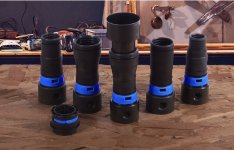nickgdowski
Member
- Joined
- Mar 4, 2023
- Messages
- 10
I just received in the mail today my new Festool ETS 125 REQ 5" sander. I was super excited to upgrade to a nice sander after using my Dewalt ROS for so long. I've used Festool in the past during my time studying woodworking in college, so I had high hopes that this budget Festool sander would live up to its prestige.
Somewhat to my disappointment when I started using it, the sander felt like it was underpowered and/or did not function properly. Compared side by side to my Dewalt, it seems slower and left a noticeable circular pattern if I remained in one place for too long. Granted I understand this is a 'finish sander' and is not meant to be extremely aggressive, but I would expect that for the price there would be a noticeable quality improvement upon first use compared to a $60 dollar sander.
I found this forum while trying to troubleshoot my problems and came upon a post that mentions a "break in" period, but the post was from 2014 and I am wondering if that is still the case with the current 2023 models? I currently have it running clamped to my workbench in the hopes that it wears in and increases the overall performance.
My second, and perhaps main concern is how to use 3M Xtract Cubitron, Net disc paper on the Festool. The 3M is listed as a net-backed, hook and loop pad but it doesn't seem to want to stick to the ETS 125. In fact, when I tried sanding with an 80-grit pad the tool wouldn't rotate properly and basically did not function, versus when I used the included 120-grit pad from Festool, the tool spun normally and at least functioned.
Is there some sort of replacement pad or additional pad I can use that would allow my tool to accept the 3M sandpaper?
Any help or clarification on this topic would be greatly appreciated, I just would like to understand how to use this tool properly and get the most out of it, or perhaps better understand its limits and capabilities.
Thank you!
Somewhat to my disappointment when I started using it, the sander felt like it was underpowered and/or did not function properly. Compared side by side to my Dewalt, it seems slower and left a noticeable circular pattern if I remained in one place for too long. Granted I understand this is a 'finish sander' and is not meant to be extremely aggressive, but I would expect that for the price there would be a noticeable quality improvement upon first use compared to a $60 dollar sander.
I found this forum while trying to troubleshoot my problems and came upon a post that mentions a "break in" period, but the post was from 2014 and I am wondering if that is still the case with the current 2023 models? I currently have it running clamped to my workbench in the hopes that it wears in and increases the overall performance.
My second, and perhaps main concern is how to use 3M Xtract Cubitron, Net disc paper on the Festool. The 3M is listed as a net-backed, hook and loop pad but it doesn't seem to want to stick to the ETS 125. In fact, when I tried sanding with an 80-grit pad the tool wouldn't rotate properly and basically did not function, versus when I used the included 120-grit pad from Festool, the tool spun normally and at least functioned.
Is there some sort of replacement pad or additional pad I can use that would allow my tool to accept the 3M sandpaper?
Any help or clarification on this topic would be greatly appreciated, I just would like to understand how to use this tool properly and get the most out of it, or perhaps better understand its limits and capabilities.
Thank you!

